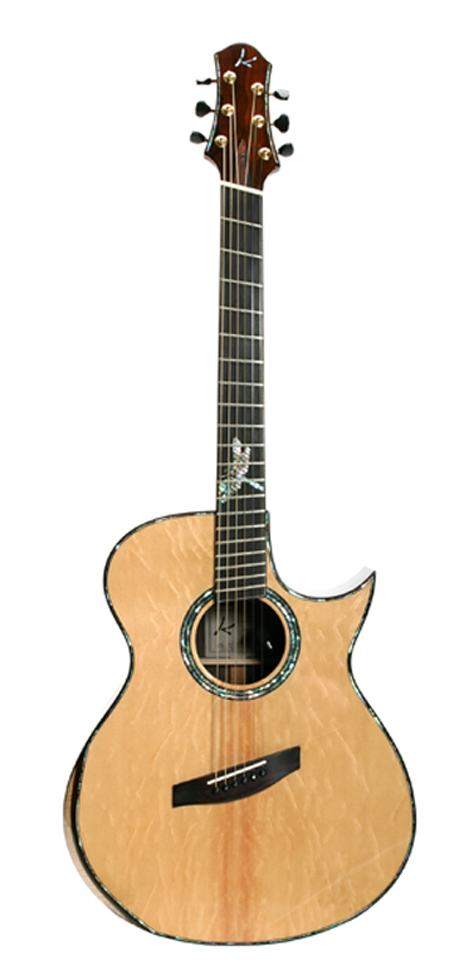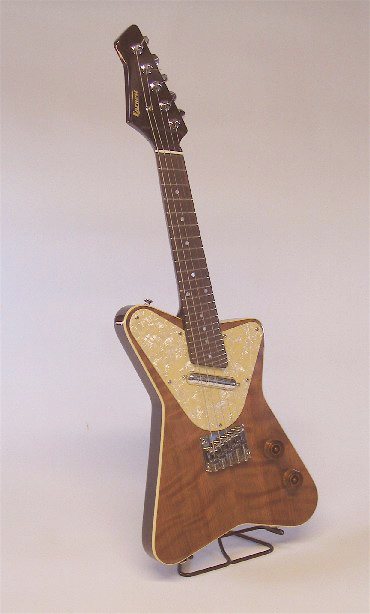here is a full frontal shot ...

| Official Luthiers Forum! http://www.luthiersforum.com/forum/ |
|
| Novax fanned fret http://www.luthiersforum.com/forum/viewtopic.php?f=10102&t=4097 |
Page 1 of 1 |
| Author: | bob J [ Wed Dec 14, 2005 12:10 am ] |
| Post subject: | |
Has anyone built, played, seen or discussed the Novax 'fanned fret' system? It seem very logical and ergonomics seem great. How about a discussion? |
|
| Author: | crazymanmichael [ Wed Dec 14, 2005 12:20 am ] |
| Post subject: | |
there was discusion or two awhile ago on this topic. have a look in the archives. |
|
| Author: | Pwoolson [ Wed Dec 14, 2005 1:06 am ] |
| Post subject: | |
Bob, talk to Paul Davis (Sprockett) as he's got the thing down pretty well. |
|
| Author: | TonyKarol [ Wed Dec 14, 2005 1:45 am ] |
| Post subject: | |
I have built played and own one ..my Dragonfly guitar, and am building two more like it, plus converting a 6 string biscuit reso into an 8 string ala CH, plus an electric CH like for a client. As well, my next personal guitar will be a baritone, 27 or so to 29 or 29.5, havent sat down to draw it all out yet (but the back and top are joined, and the sides bent !!) Its a necessity when you are trying to use such variable string gauges, and a wide tuning range in order to get the thing to sound reasonable - how good would a low E off a bass sound at 25 inches ??? lousy. It needs to be in the 29 range at at least, and probably not with a 100 guage string either, more like 120 or 125. But at the same token, how does ahigh E guitar sound at 29 inches - way too tight and bright. its needs to stay around 25. So multiscaling is the only option to get it all together. |
|
| Author: | TonyKarol [ Wed Dec 14, 2005 1:56 am ] |
| Post subject: | |
here is a full frontal shot ... 
|
|
| Author: | Sprockett [ Wed Dec 14, 2005 6:46 am ] |
| Post subject: | |
The 'Novax' system has been around a lot longer than many think, it was tried in the very early part of the last century, Harry Fleishman did it before Ralph and calls his a variable scale guitar (or something like that). I've built two guitars, the scale was 27" on the low end and 24.75 on the upper, for pictures you can go here and see the guitar: Guitar Gallery click on the guitars tab, you'll see one in there... My fret angle is much more pronounced that Tony's but that was at the players request and I must say that it makes playing much easier. The hardest part is getting the saddle position set, you have to factor in compensation when setting the position. -Paul- |
|
| Author: | Alan Carruth [ Wed Dec 14, 2005 10:25 am ] |
| Post subject: | |
Fanned frets go back to the 'Orpharion', a type of cittern in the Rennaissence, iirc. This was before the days of wound strings, and it was the only way to get good sounding low notes. Ralph devised his setup without knowing about the prior art, and with a specific thing in mind. He conjectured that a plucked string could have a high frequency wave travling up and down it similar to the sort of wave you get in a long thin tube, and that this could effect the vibration of the string in other senses, such as the 'transverse' vibration that an electric guitar pickup, um, picks up. The pitch of this wave is pretty much only dependant on the length and material of the string, and is independant of the pitch the string is tuned to for steel strings as far as I can find out. He posited that this was one of the things that makes Strats and Les Pauls sound different. His aim was to get the same low string sound as a Strat and the high string sound of a Les Paul. His patent is based on this claim. I've been measuring the different vibrations of plucked strings recently, and I think he may have something. Note that, at least in theory, you can use the idea so long as you don't claim the thing that his patent specifically protects; Strat bass and Les Paul treble. I don't have the original patent, so I can't say how broadly it's worded, although those lawyers usually try to cover everything between whipped cream and gravity if they can. Note, too, that Ralph has had some medical problems, and he's a nice guy, so that weasel wording just to avoid paying the fee is sort of mean. |
|
| Author: | Sprockett [ Wed Dec 14, 2005 11:20 am ] |
| Post subject: | |
Alan.. On each of my Fanned Fret guitars I've paid Ralph the licensing fee and will continue to do so on any future projects, I like Ralph even if he is a little crusty sometimes 
The first fanned fret I did I spent a couple hours in his shop just chatting with him about it, he's quit a character that's for sure. I'm not sure what the relationship between Ralph and Harry is and I'll leave to them, but I know that they have known each other for a long time. I learned a lot from just sitting and talking to him, he's a gold mine of information about guitars... I think his theory makes lots of sense, it's the same idea as a pianos sound frame with the bass strings being much longer than the higher ones. The two guitars that I built both have very very nice highs and with thick 6th strings really give a good bass tone. Cheers -Paul- |
|
| Author: | bob J [ Thu Dec 15, 2005 2:06 am ] |
| Post subject: | |
bump |
|
| Author: | spruce [ Thu Dec 15, 2005 4:53 am ] |
| Post subject: | |
I play one of Joel Eckhaus' Boomerang 5-string mandolins with the Novax fanned fretting system... Five or ten-string mandos are notorious for not quite working, with the C string needing a different scale length than the E.... This seems to solve the problem.... 
|
|
| Author: | Howard Klepper [ Thu Dec 15, 2005 6:08 am ] |
| Post subject: | |
"Note that, at least in theory, you can use the idea so long as you don't claim the thing that his patent specifically protects; Strat bass and Les Paul treble." I believe this is wrong. Patent protects the device or method; not the intended result of using it. |
|
| Author: | tl507362 [ Thu Dec 15, 2005 6:13 am ] |
| Post subject: | |
Bob, If you had come to the CO Luthiers meeting at Michael Bashkins shop 4 months ago, you could have learned how to do this. You may see Michael at one of the next meetings and you can ask him how to do it. He is very good about sharing information. Tracy |
|
| Author: | Mike Mahar [ Thu Dec 15, 2005 7:12 am ] |
| Post subject: | |
I just read the patent and the claim seems to be that any non-parallel fretting system design to change the scale length is covered by the patent. The patent does describe why you might want to have different scale lengths which is because of the different tone color different scale lengths have. If I read the patent correctly, having non parallel frets to address temperment issues might not be covered. The patent doesn't seem to address curved frets. It is mute on the subject. |
|
| Author: | Alan Carruth [ Thu Dec 15, 2005 11:38 am ] |
| Post subject: | |
Howard Klepper wrote: 'I believe this is wrong. Patent protects the device or method; not the intended result of using it.' Well, I'm no patent attorney, that's for sure. However, my understanding is that patents are meant to protect ideas that are new and are not obvious to any practitioner in the field. If a device is not new, it might still be patentable if you can show that your use of it is something that nobody else would have thought of. Then your patent covers that use. 'White-out' was patentable, even though paint has been known for a long time, because nobody else had thought of using paint to fix typos. But the patent doesn't cover white paint, or even white paint with a particular formula, I don't think; it covers the use and the packaging that makes that use easy. Using fanned frets to make the bass strings sound better is not a new idea, and should not be covered per se in the patent. Using fanned frets to get a particular effect because of a particular property of strings on electric solid body guitars was a new idea. One of the problems here is the way patents are done these days. The time when they had an Einstien in the back office reviewing patents and weeding out the obvious no-gos is gone. Now they just issue the patents and leave it for the courts to settle. If the patent is held by a big corporation with lots of lawyers, it stands. If it's something like fanned frets, that just isn't worth anybody's effort to contest, it stands. Ralph was unaware of the prior art when he filed for that patent. His lawyer did a good job of covering all possible uses and variations in the specification, but he didn't know about the prior art either. Orpharions are not something you run into very often. I imagine if you took it to court the thing would be voided. Why bother. |
|
| Author: | mrpbody44 [ Thu Dec 15, 2005 2:27 pm ] |
| Post subject: | |
One problem with patents is that you have to defend them. As an engineer I have had several pattenable ideas. The markets for the ideas were so small that it just was not worth going through the hassle and later spending more money defending the patent. I have had several friends spend lots of money defending patents. |
|
| Page 1 of 1 | All times are UTC - 5 hours |
| Powered by phpBB® Forum Software © phpBB Group http://www.phpbb.com/ |
|